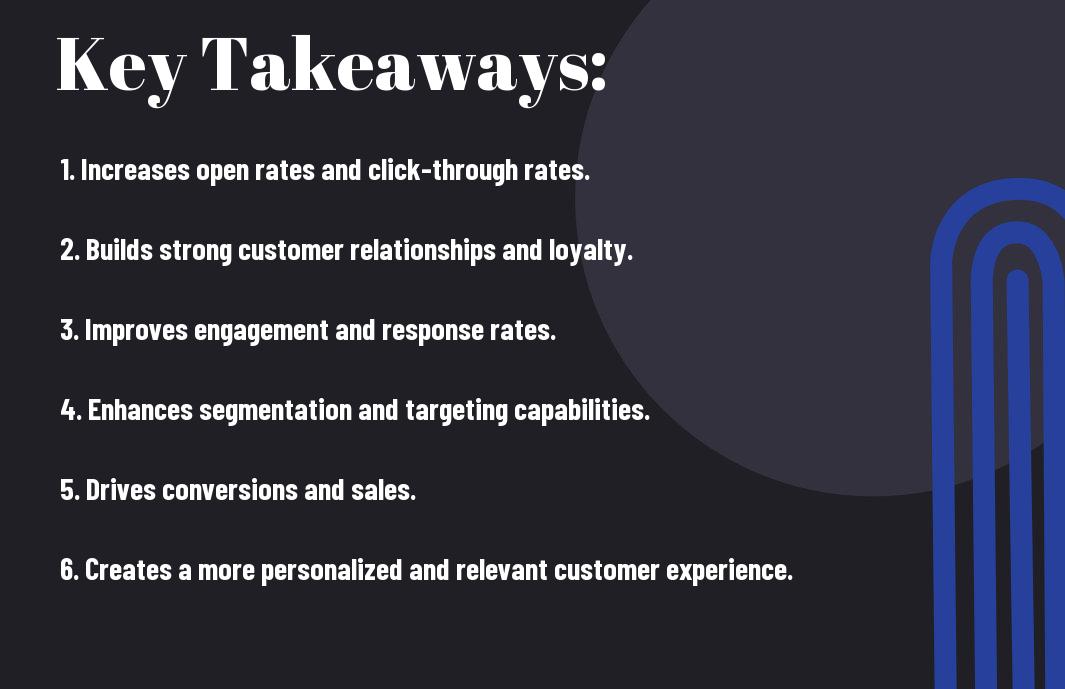Power up your email marketing strategy with the game-changing tool – personalization. Personalizing your email content is not just a trend, it's a powerful strategy that can significantly increase engagement, open rates, and ultimately, conversion rates. By segmenting your email lists based on customer preferences, behaviors, or purchase history, you can tailor your content to their needs and interests. This approach creates a more personalized and impactful experience for your subscribers, building trust and loyalty with your brand. Don't miss out on the opportunity to harness the power of personalization in your email marketing campaigns. Embrace it and watch your results soar.
Key Takeaways:
- Increased Engagement: Personalized emails have higher open and click-through rates, leading to better engagement with subscribers.
- Improved Conversions: Tailoring emails to individual preferences and behaviors can result in higher conversion rates and ultimately increased sales.
- Enhanced Customer Relationships: Personalization in email marketing can help build stronger connections with customers, leading to increased loyalty and repeat business.


Benefits of Personalized Email Marketing
Increased Engagement and Open Rates
One of the key benefits of personalized email marketing is the increased engagement and open rates it generates. By tailoring emails to specific individuals based on their preferences, behavior, and demographics, marketers can capture their attention and drive higher open rates. Personalized subject lines and content make subscribers more likely to engage with the email, leading to higher click-through rates and ultimately, increased conversions.
Improved Customer Retention
Email marketing allows for personalized communication with customers, enhancing relationships and fostering loyalty. By sending targeted and relevant content to customers based on their past interactions with the brand, marketers can deepen engagement and increase customer retention. This personalized approach shows customers that their preferences are valued, leading to long-term relationships and repeat business.
Rates: Personalized emails have been shown to improve customer retention rates significantly. By delivering tailored content that resonates with individual customers, businesses can foster loyalty and keep customers coming back for more. This targeted communication strategy not only enhances the customer experience but also boosts brand loyalty and long-term profitability.
Strategies for Personalizing Email Campaigns
Segmenting Your Audience
Email marketing campaigns can significantly benefit from segmenting your audience based on their demographics, behaviors, or preferences. By segmenting your audience, you can send personalized content that resonates with each group. This ensures that your subscribers receive relevant information, leading to higher engagement and conversions.
Utilizing Data-Driven Insights
Insights from data-driven analysis can help you understand your audience better and tailor your email campaigns to their needs. By leveraging analytics to track open rates, click-through rates, and customer behavior, you can create personalized campaigns that are more likely to drive results. Utilizing data can also help you identify trends and opportunities to optimize your email marketing strategies.
Segmenting your audience based on data insights allows you to deliver targeted content that meets the specific preferences of each group. This can lead to higher engagement rates and ultimately, better ROI for your email marketing efforts.
Implementing Personalization Effectively
After researching the article on Personalisation (In)effectiveness in email marketing, it is crucial to understand how to implement personalization effectively in email marketing campaigns.
Tools and Technologies to Leverage
An necessary aspect of implementing personalization effectively in email marketing is leveraging the right tools and technologies. Tools like customer relationship management (CRM) systems, marketing automation platforms, and data analytics software can help businesses gather, analyze, and utilize customer data to personalize their email campaigns. By leveraging these technologies, businesses can create targeted and tailored content that resonates with their audience, ultimately leading to higher open rates, click-through rates, and conversions.
Crafting a Personalized Email Journey
For crafting a personalized email journey, businesses need to segment their audience based on various criteria such as demographics, purchase history, and online behavior. By creating customer personas and mapping out the customer journey, businesses can deliver the right content to the right audience at the right time. Personalizing the email journey requires dynamic content creation, A/B testing, and automation to ensure that each subscriber receives relevant and engaging content throughout their interaction with the brand.
To maximize the effectiveness of personalization in email marketing, businesses should continuously monitor and analyze the performance of their campaigns, iterate on their strategies based on data-driven insights, and always prioritize maintaining a balance between personalization and privacy to cultivate trust with their audience.
Common Pitfalls and How to Avoid Them
Balancing Personalization with Privacy
Your customers are more aware than ever of the importance of their privacy. While personalization can greatly enhance their email experience, it is crucial to strike a balance between providing tailored content and respecting their boundaries. One of the key pitfalls to avoid is crossing the line from personalization to intrusion. To avoid this, always ensure that you have explicit consent for the data you are using for personalization and be transparent about how you will use it.
Ensuring Personalization Scalability
On the other hand, as your email list grows, maintaining the same level of personalization can become a challenge. It is important to have systems in place that allow for scalability. This could involve using automation tools to segment your audience based on their behavior and preferences, or regularly updating your customer data to ensure its accuracy. By staying proactive in managing the scalability of your personalization efforts, you can continue to provide a personalized experience to a growing audience.
To wrap up
On the whole, personalization plays a crucial role in the success of email marketing. By tailoring content to individual preferences and behaviors, businesses can foster stronger connections with their audience, drive higher engagement rates, and ultimately boost conversions. Utilizing personalization tactics such as dynamic content, segmentation, and personalized recommendations can help create more relevant and compelling email campaigns that resonate with subscribers. As the digital landscape continues to evolve, incorporating personalization strategies will remain a key component of any effective email marketing strategy to deliver personalized experiences that drive results.
FAQ
Q: What is the power of personalization in email marketing?
A: Personalization in email marketing is the practice of tailoring email content to individual subscribers based on their preferences, behaviors, and past interactions with your brand. By delivering targeted and relevant messages, personalization can significantly increase engagement, conversions, and customer loyalty.
Q: How can personalization enhance the effectiveness of email marketing campaigns?
A: Personalization helps email marketers create more meaningful connections with their audience by delivering content that resonates with each recipient. By segmenting your email list, using dynamic content, and leveraging data insights, you can deliver highly personalized messages that drive higher open rates, click-through rates, and ultimately, revenue.
What are some key strategies for implementing personalization in email marketing?
A: Some key strategies for implementing personalization in email marketing include collecting and analyzing customer data, segmenting your email list based on demographics or behavior, using dynamic tags to insert personalized information, creating targeted automation sequences, and testing and optimizing your campaigns for better results. By following these strategies, you can harness the power of personalization to create more engaging and effective email marketing campaigns.